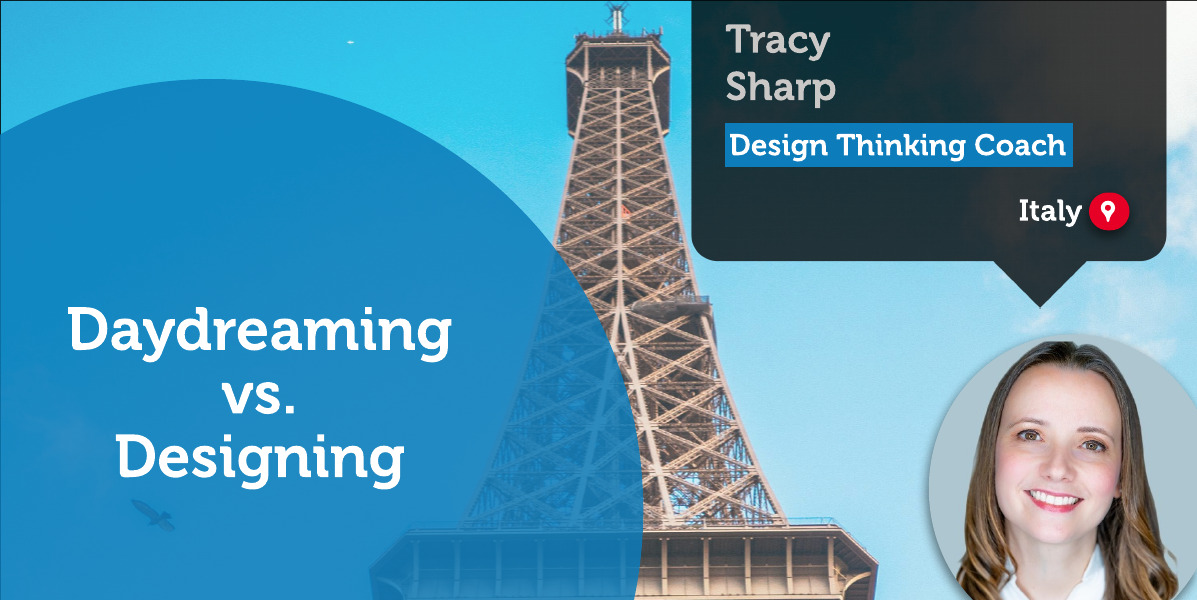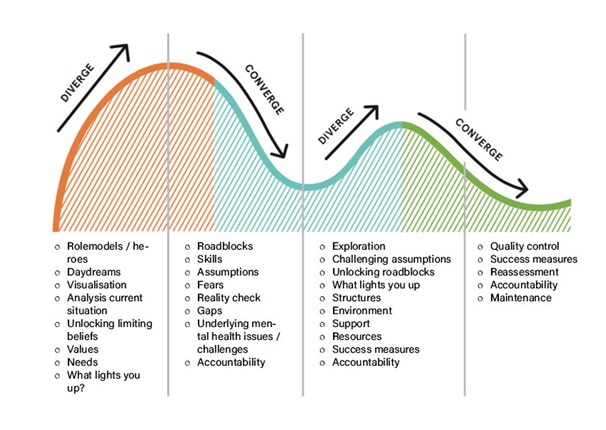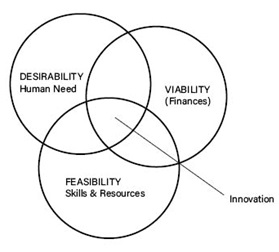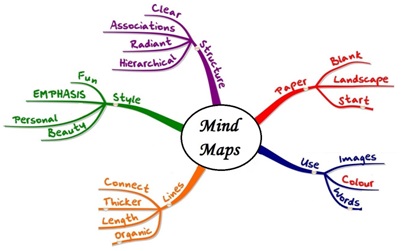A Coaching Power Tool By Tracy Sharp, Design Thinking Coach, ITALY

Definition of Daydreaming vs. Designing
Vision without execution is daydreaming. Bill Gates
Daydream:
The activity of thinking about pleasant things that you would like to do or have happen to you instead of thinking about what is happening now. (Cambridge Dictionary)
Design:
The art or process on deciding how something will look, work etc by drawing plans, making computer models. (Oxford Dictionary)
Although there is great power in daydreaming and in fact, most great visons for the items we interact with every day would have started from a ‘What if’ scenario followed by a dreaming process. But in turn, daydreams are distractions from what is going on in life at that moment and could be a recurring hindrance to our productivity and focus.
If clients are not focused on the now, then they are not moving forward or realizing what could be modified to benefit them. Also, it could be a sign of boredom;
Well it’s not just a daydream if you decide to make it your life. Train – Drops of Jupiter
Personal Example
I’m originally from the UK and spent 6 years living in London. It had been my dream to live there, and I dived into all aspects of life – concerts, exhibitions, markets, theatre, and work. Every year, I made a list of things I wanted to do as a new year’s resolution, but I realized that after year 5, I felt that I had done it all and there was nothing new on my list. There were events that I loved so much that I did it again, but I felt a little bored with its traditions.
I travelled often to China with work and recognized the opportunities there. But I had a limiting belief about my professional abilities, language barriers, and relationships with the team in China already. These prevented me from taking action to discuss it with my superiors.
But the daydream never went away of what my life could be.
I worked on my limiting beliefs; studying mandarin to learn the basics and gained more responsibility and exposure at my job to give myself confidence that I could be a technical lead.
One evening, I asked myself the question ‘What if I worked for a different team in China?’. I had seen other colleagues transfer from one group to another without issue. This could help with my relationship with the team I was currently working with, as I would no longer be working with them. I would have a fresh start by building my own possibilities.
Suddenly, my daydream was like reality and the next step was to inform my boss of my request for a secondment. From the moment I said, ‘I want you to send me to China’, I had full support from the company and began the process for my visa. I moved there in April 2017 and lived there until September 2020.
The first reflection on my experience is that I was very aware of my daydreams to relocate. I knew that this dream could serve me in my future to move forward. Dreams open our minds to possibilities and help build awareness of what needs to change.
Daydreaming vs. Designing: What’s the Difference?
The key difference between daydreaming and designing is ACTION and PROCESS. The best blue-sky designers are big daydreamers but there are processes in design thinking which can allow you to filter and channel the energy from the initial design stages to ensure that the result has been effectively designed. In life, you don’t need to be an artist or know how to use photoshop to design it. The key is realizing that there is already a process, Design Thinking.
What is Design Thinking?
Design can help improve our lives in the present. Design thinking can help us chart a path into the future. Tim Brown
Depending on your source, there can be between 3 and 7 stages in the design thinking process, but the core is to understand, explore and materialize daydreams through the inspiration, ideation, and implementation stages, respectively. This concept comes from an innovation consultancy, IDEO, which pioneered the concept of Human-Centered Design which relies on having the deepest empathy for the end-user to fully understand the need for a new solution.
Below is the image to explain the process overview.

Think of inspiration as the problem or opportunity that motivates the search for solutions; ideation as the process of generating, developing, and testing ideas; and implementation as the path that leads from the project stage into people’s lives. says Tim Brown and Jocelyn Wyatt.
You will notice that there are several points of divergence and convergence, this is in relation to idea generation for the alternate outcome for the client, which could originate from coaching or indeed daydreams of the client.
The Key Principles of Coaching
Using some of the key principles of coaching, I have overlaid the tools and techniques over the design thinking principle in the image below
 Take note that accountability appears in 3 out of the 4 stages; this will be a constantly monitored set of parameters that are likely to be modified as the project moves forward as what can and cannot be done and as the client understands more about their own potential.
Take note that accountability appears in 3 out of the 4 stages; this will be a constantly monitored set of parameters that are likely to be modified as the project moves forward as what can and cannot be done and as the client understands more about their own potential.
Phase 1 – Inspiration
As with any coaching case, the first stage is to allow the coach and the client to fully understand the current situation.
We can begin by enquiring with the client about their dreams or about any visualizations of what their ideal outcome could look like.
It can be beneficial to bring awareness as to what and when they are daydreaming. It could be boredom or avoidance from a key mental block they are going through or could also be positive or negative.
- When do you find your mind wandering?
- Which of your daydreams is good?
- Which daydreams really get your heart racing and give you a spike in energy?
- Do certain daydreams repeat?
If there are recurring negative or disturbing daydreams, at this point, there would need to be an evaluation by the coach or if the client needs some mental health care or counseling.
However, if the client’s mind is wandering during the same task, it could be an opportunity to explore what is the direct cause.
- What is it about this task that leads your mind wandering?
- How essential is this task to your daily life?
You can also discover when the client is low on engagement for their daily tasks, at work or in life, and if the task is something which perhaps is not essential but the client feels they are responsible for.
Once this has been established with the coach and client, you can then go on to flip the discussion and discover when the client IS engaged and what is it when they feel at their best.
- What lights you up
- What job or task would you do happily for free?
- What is missing for you at this point?
- What are the top 5 values which you use to guide your key decision-making process (established using a values analysis)
There might be parallels between what is discovered through this line of questioning and the positive daydreams which were discussed previously.
In design thinking, there is a key to ensuring that the direction being taken is correct and before we proceed to further stages, there must be an acknowledgment of one of the first stages, Empathy.
In the context of coaching, this will transpire as self-awareness. Normally designers will try to empathize with the end-user to determine what problem needs to be solved by a design update. However, as the coach does not provide solutions to clients, the designer would be the client. The empathy gathered is by the self for the self. Once there has been a clear analysis of the current situation, where we need to take the client is to have them ask themselves a question, what do they NEED? To dive into this, there is an option of creating an Empathy Map, which allows the client to understand what it is they think and feel, they see (in comparison to others), they hear (external influences, media, family & friends), and what they say and do (from interviews with the client, using active listening and direct communication to notice for patterns in speech and body language and pay attention to tasks which come up).
At this point, it is likely that there will be some key areas identified that will need further evaluation and coaching, but also, there will be an abundance of information that can be used for the next steps.
But it is most likely that it will be possible for the client to pin their most urgent need that needs to be addressed.
In my research I also repeatedly found myself learning more about the laddering technique. This is not a coaching technique but is incredibly powerful to really understand the basic motivations of the client and drill down into their essence and core being using how and why questions.
It is difficult to use this in coaching mostly because the idea is to use the word ‘why’ which can elicit feelings of accusations and judgment.
In my research, I did find an exercise in Creativity by Paulina Larocca, which used slightly different questions.
After the empathy map, the client may have an overall question to be asked. Using this exploring exercise, a statement beginning with ‘Imagine…’ is written in the middle of a piece of paper (e.g. Imagine there is a world where I live and work in China’). Then the client can move up the page asking, ‘What is important to you about this?’ and the objective is to answer the question in the form of a ‘What if’ or a ‘How can I’ statement. Continue this exercise through multiple answers and through multiple levels to get to the core need or limiting belief.
Then the client returns to the middle of the page and works downwards, asking ‘what’s stopping you?’. Continue this downwards as widely and deeply as possible.
With this chart, the client can look at areas that need to be addressed and questions that could be answered in other subsequent coaching sessions, in the convergence stage. They will have a clearer self-awareness of their current situation, more about their fundamentals of being and what excites them, and what question in their life needs to be answered.
Divergence to Convergence

Human Design Thinking believes that there is a sweet spot in which innovation lives. It is in the overlap between what the human need is (explored in the previous section) and then the feasibility and viability.
This would be the same for clients and designing, but with a slightly different vocabulary as seen in the figure above.
This takes us on to the next step which is to move from divergence to a convergence of ideas. Although there will be high energy and ideas from the client during the inspiration phase, there needs to be a reality check of being achieved i.e. if we use the example given at the beginning of the report regarding my decision to move to China, I had to go through a long process to arrange my visa, accommodation and new contract. This needed to be done.
If a client wants to change their job, retrain, or start their own business, there will likely need to be a point to think about what could be done within the realities of their skills, expertise, and finances. At this point, tools could be prepared by the coach as needed for such eventualities – budget trackers and planners, skills finders, immigration requirements, etc.
Then there must be an exploration of the potential roadblocks of the client; any underlying fears, or limiting beliefs, can be coached or counseled as appropriate.
- What skills do you think you need to achieve this dream?
- Which of these do you already have?
- How long would it take to train to fill the gaps which are missing
- Who could help you fill the gaps in the skill base?
This may reduce possibilities in the mind of the client (i.e. convergence) but with the correct understanding of the client, there can be careful control of this to ensure that the limiting beliefs are not triggered. Having an overview of the clients limiting beliefs in advance can ensure the convergence is not too much and the client’s confidence has waned.
In my experience of coaching, especially with female clients, I noticed that it was common for them to believe that further training or qualifications are needed to work in a different field. This is not always the case and should be challenged within the coaching space (Using Byron Katie’s 4 questions);
- Is this true?
Phase 2 – Ideation
At this point, the client has a firm understanding of their needs, their limiting beliefs unlocked, and their reality checked. Design thinking can be used again to add further exploration of what capabilities, skills, and resources the client already has shared and has awareness of.
This information can be quite overwhelming to keep in your mind at any given moment.
Mind mapping, a phrase coined in the 1970s by Tony Buzan is a valuable tool to help lay out the thoughts of the client in free form. Instead of writing a simple list, a mind map visualizes a train of thought more clearly and can support multiple trains of thought simultaneously whilst focusing on a single key central concept and extending out in a hierarchy.
The use of mind maps itself is very useful and to the preference of the client, with the possibility of using images, colors, and words to collect thoughts together and in fact can be less overwhelming to view instead of a table or list.
This method is best used if the client is working alone; there are other tools available if the client can bring in other people to collaborate.
 The client can brainstorm in the mind map and create several options to move forward into the implementation stage.
The client can brainstorm in the mind map and create several options to move forward into the implementation stage.
The idea does not have to be fully realized at this point but instead can be used to make connections across idea threads.
To originate the mind map, there can be some instinct about where to start, but the empathy map and laddering and reality check will have helped to converge the thoughts.
Alternately to the brainstorming, the client could engage in a ‘traditional’ brainstorming session and bring support from other people to help bounce ideas around and stay focused.
This involves producing more complete ideas of how to solve the client’s need and is normally conducted as a group, using post-it notes, pens, and a whiteboard. Ideally, a small sketch (if this was a product brainstorm) would be added, and once complete, the post its would be stuck to the whiteboard. Wild ideas are welcomed because they can be used to launch further practical ideas. IDEO also explores this as an exercise in their ‘unlocking creativity’ course, ‘The Really Bad Ideas Brainstorm’. It allows the participants to feel comfortable in sharing all ideas, regardless of the origin and that failure is a natural part of creating ideas.
When Brainstorming, we can again look to design thinking principles for success;
- Defer judgment
- Encourage wild ideas
- Build on the ideas of others
- Stay focused on the topic
- One idea at a time
- Be visual
- Go for quantity
Once the mind map or brainstorm is complete, then the client and coach can work together to bring designs to ‘prototype’ moving forward. It is essential to ensure that the client is clear about what are the success parameters and the timeline to review and ensure that we keep in mind the question asked in phase 1 about the client’s core need.
Normally at the end of ideation, there can be several exciting concepts that can be swapped around, combined, or synced with reality.
Questions that could be asked
- How will we know that we have found a solution that could work for you?
- What could a successful solution look like to you?
- What jumps off the page at this moment?
- What excites you?
- What comes up for you when you review this mind map?
- How can what you see in the mind map connect with your overall goal?
- How would you adjust or combine any of these concepts?
One of the key elements of designing is the concept of prototyping. A prototype is defined as;
The first example of something, such as a machine or other industrial product from which all later forms are developed
So many people have daydreams which would take you so far from their current situation. A different life, a different country, a different career. This can be incredibly intimidating to begin, never mind execute. A prototype gives you a path of trials towards something different, without the feeling of having to give up everything in the process only to realize that it is not right for you.
The key aspect of design thinking here is iterative learning. Each prototype provides you with data that can be used to make judgments and decisions on the final solution or a further version of the prototype which can be tested. This helps the client develop a growth mindset and consider life’s challenges using a structured and consistent approach.
- What actions can you take to help create your prototype?
- What do you hope to learn in this prototype?
- How will you know you have been successful?
- How long would you like to test this scenario before reviewing it with your coach?
- How will you hold yourself accountable to achieve these actions?
- Who will you need to support you on this?
Phase 3 – Implementation
At this point, the client has established actions and structures to be clear about how their life design prototype could be successful and duration to allow the client to try or ‘test’ it.
Several life designs could be built at this point, allowing several options, ‘prototypes’, and learning points for the client and a greater chance of success in adoption.
A period of time, devised by the client will be created allowing a time frame for the client and coach to check back in with each other. It is suggested that the coach create a ‘check in’ period in between (i.e., if the client needs 3 months to test the prototype, the coach has a check-in at 1 and 2 months). This will ensure that the client is accountable and to check on progress. There can also be a review and adjustment of the prototype and the success measures if the client is not receiving the information, they require to be sure to ‘implement’
It is expected that some prototypes will ‘fail’ or not provide the correct information needed to implement. With design thinking and designing this is completely normal. However, it is important to understand what is being learned and how best to use that information.
- What came up for you as you were testing this design?
- How successful was this project?
- What were the parameters which most influenced these feelings?
- What did you learn?
- What were you surprised about?
- If you had to repeat the test, what would you change?
- If you had to repeat the test, what more would you be curious about and how could you design a new prototype to help you?
There is also another great design thinking tool used for reflection and evaluation; I like, I wish, I wonder.
The client can use this to give a structured response to how the prototype had been tested, what was missing for them, and how they could implement further changes to help them fill the gaps of what was missing for them.
This process could continue at length until the client has reached a design – whether it is a business idea, habit, hobby, or life approach – that they are willing to continue with.
It’s a Creative Process: Daydreaming vs. Designing
Daydreams can be distracting, but with the right process and mindset can be turned into designs that could positively impact the lives of many.
The design thinking process can be used across several worlds but the core is the same; it is important that the end-user has a need met and that a successful end goal can only be reached through an iterative and learning approach, with clear success and failure parameters. Reaching the end goal can be perceived as having many ‘failures’ attached to it, but with an awareness of the learning outcomes from each of these and an opportunity to adjust and continue to monitor with the correctly defined controls, the client’s end goal can be achieved and ongoing philosophy of trial and improvement can be instilled.
With the right coach, the client can be inspired, can ideate great solutions, and can implement life changes iteratively and successfully with the right intention.
References
http://www.usamahkhan.com/projects/tag/Design
https://nextbillion.net/design-thinking-inspire-ideate-and-implement/
https://www.psychologytoday.com/us/blog/the-power-daydreaming/201001/how-work-your-daydreams
The design thinking toolbox - Michael Lerwick, Patrick Link, Larry Leifer
Creativity + - Paulina Larocca
http://businessvaluedesign.be/design-thinking/
https://www.ideou.com/blogs/inspiration/what-is-design-thinking
https://thework.com/instruction-the-work-byron-katie/
https://en.wikipedia.org/wiki/Mind_map
https://www.lifehack.org/articles/work/how-to-mind-map-in-three-small-steps.html
https://www.ideou.com/blogs/inspiration/7-simple-rules-of-brainstorming
https://dictionary.cambridge.org/dictionary/english/prototype